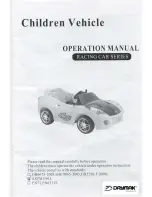
9
Tips for Success
•
Only operate the throttle stick gently with small inputs, the most common form of damage is due to reducing
the throttle by large amounts causing sudden reductions in height and crashing.
•
When your helicopter begins to climb slowly or is unable to climb on full throttle then the battery is beginning
to run low, for safety land your model as soon as possible and re-charge.
•
Damage or bends to the blades or fuselage can greatly affect flight control. Replace damaged parts
immediately.
•
Don’t attempt to fly or do manoeuvres beyond your flying abilities.
Learning Sideways Flight
1.
Hover your helicopter 1 metre in the air.
2.
Move the cyclic control stick sideways gently and release it, your helicopter will move sideways then hover
stationary.
3.
Reduce the throttle stick and land your helicopter returning it to its starting position.
4.
Repeat this exercise but prior to landing move the cyclic stick back to return the helicopter to its starting
position whilst in flight.
Combining Controls
1.
Hover your helicopter 1 metre in the air.
2.
Move the cyclic stick forwards and hold its position to achieve a slow forward flight.
3.
Move the rudder stick left or right and your helicopter will begin to fly in a circular motion.
4.
Practice turning left and right circles of small and large diameters.
By combining control inputs you will be able to control your helicopter position accurately and fly in more advanced
patterns such as figure of eight or carry out simple aerobatic manoeuvres.
Once confidence and control has been gained experiment by increasing the hovering height to 2 to 3 metres and
combining forwards, backwards, sideways and turn controls.
Summary of Contents for PULSAR150
Page 1: ...INSTRUCTION MANUAL ML43034...
Page 58: ......
Page 59: ......
Page 60: ...MIRAGE RC ENTERPRISES LTD 19 WILLIAM NADIN WAY SWADLINCOTE DERBYSHIRE DE11 0BB UNITED KINGDOM...












































